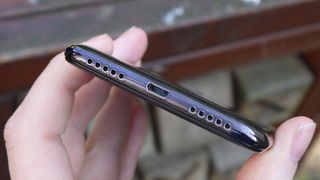Why you can trust TechRadar
Battery life
Perhaps the most reassuringly familiar thing about the rather unusual ROKiT IO Pro 3D is its battery performance – at 3,850mAh it’s a sizeable power pack, more than enough for a day of moderate to heavy use, and it’ll likely last two days if you don’t use your phone for anything demanding.
The battery didn’t hold up very well when it came to playing media, however. When we subjected the phone to our battery test, in which we turn brightness up to full, let accounts sync over Wi-Fi, and run a 90-minute video, we found the battery dropped 18%, which is a sizeable amount when most phones lose 10-15%, and playing games drained the power at a similarly fast rate.

This seemed to be the case for 3D content too, but as we’ve mentioned we weren’t keen to use the 3D features of the phone for long periods, so weren’t able to fully test their effect on battery life.
Rapidly losing charge when playing media is understandable for a handset, however, even one for which content streaming is one of the main draws, and the large power pack stopped this being a huge problem.
Charging up was a different story however, as it took a whopping two hours and 15 minutes for the device to get from 0% to full, likely due to the micro USB connection, and there’s no wireless charging either. That’s a frustrating amount of time to have to wait – even the Moto G7 Power only takes around two hours to charge to full, and that handset has a 5,000mAh battery.
Camera
The ROKiT IO Pro 3D has a dual rear camera setup, consisting of 12MP f/2.2 and 2MP snappers – ROKiT didn’t get back to us before publishing on the aperture or lens of the second, so we don’t know its speciality, but we tested the cameras in a range of settings to get a sense of their strengths and weaknesses.


Overall the best word to describe the camera performance is ‘fine’. The pictures we took weren’t high-quality, and there aren’t a huge suite of features to help optimize your shots – but you’re probably not buying the ROKiT IO Pro 3D if you want a device with a powerful camera and you won’t be disappointed by its mid-range performance.


Photos we took were a mixed bag – colors were rendered well, and they weren’t boosted so far that they looked unnatural, but a lack of depth was apparent in pictures, and when we used zoom these photos were noticeably grainy.
Pictures also seemed a little darker than the scenes in real life, which made an overcast daylight shot look like a sunset and low-light shots almost impossible to see.
On the front of the phone is the 8MP front camera – again we don’t know the aperture, or whether it’s supposed to have any particular tricks up its sleeve. We found this as competent as you’d need for a selfie camera.


The main appeal of the camera is that it can shoot both photos and video in 3D, and we made sure to test this feature out.
When you take a 3D picture with the camera, you need to hold the shutter button and move the phone 1cm to the side to create a profile of your subject. That’s a lot easier said than done – most of the time we did this the render would fail and we’d had to try again, and at times the picture would be taken, and would fail, before we’d even lifted our finger.
The resulting images were very hit-or-miss, with the majority being misses for the same reason as the rest of the 3D content, although when we tried hard we took photos that actually looked surprisingly good – and those were the only instances when we found the 3D effect looked palatable.
We tried 3D video too, but the clips only looked like standard videos – with the addition of the haze effect that we couldn’t stand when looking at other 3D content.
You can’t export 3D pictures or videos, which is understandable since most other phones wouldn’t be able to display them, but it does make the strange 3D effect hard to show in a review.
Current page: Battery life and camera
Prev Page Special features Next Page Anything else I should know?
Tom Bedford was deputy phones editor on TechRadar until late 2022, having worked his way up from staff writer. Though he specialized in phones and tablets, he also took on other tech like electric scooters, smartwatches, fitness, mobile gaming and more. He is based in London, UK and now works for the entertainment site What To Watch.
He graduated in American Literature and Creative Writing from the University of East Anglia. Prior to working on TechRadar, he freelanced in tech, gaming and entertainment, and also spent many years working as a mixologist. He also currently works in film as a screenwriter, director and producer.
